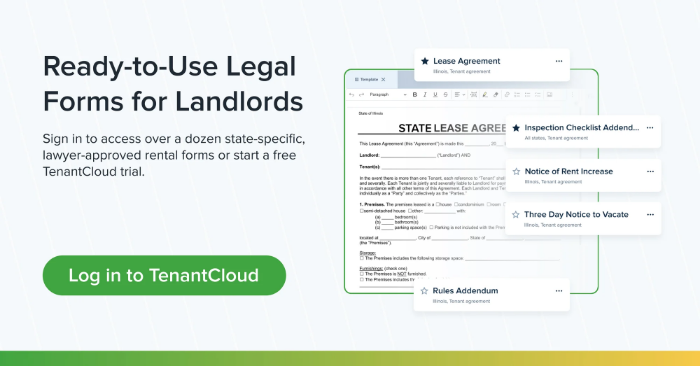Evictions can be overwhelming for both landlord and tenant. In Indiana, eviction laws vary from state to state—and even county to county—so, it can be a confusing experience for anyone new to the process.
Each eviction process depends on your lease agreement, property location, and other important details, which we’ll go over below. The more you understand each step and what to expect along the way, the more successful the outcome.
In this article, we’ll go over everything a landlord needs to know when evicting a tenant. We'll also discuss the rights of both landlords and tenants and provide tips for record-keeping to help avoid issues during eviction.
Let’s get started.
What Constitutes an Eviction in Indiana?
In Indiana, eviction is the legal process by which landlords can remove tenants from their property. This can occur due to various reasons, such as failure to pay rent, lease violations, property damage, and more, which we’ll go over below.

Reasons to Evict a Tenant
Like many other states, in Indiana, a landlord can’t evict tenants on their own. Even if the tenant has signed a lease agreement, they have rights to the property as outlined in the lease, unless they do in any of the following:
- Fail to Pay Rent: In Indiana, a landlord can evict a tenant for falling behind on rent. Typically, a landlord must give the tenant an official written 10-day notice of payment. If rent is paid within 10 days after the tenant receives the written notice, then the landlord can not continue the eviction process.
- Violate Lease terms: A rental lease agreement must be upheld by both parties of the agreement. If a tenant violates these terms outlined in the agreement, the landlord must provide a written notice and be given a reasonable amount of time to correct the violation. If the tenant does not comply, a landlord can start the eviction process.
- Damage or Disturb the Property: If a tenant damages the property or disturbs neighbors or other tenants, they may be breaking the lease agreement and could be evicted for their behavior. In this case, a landlord needs to provide a written notice and provide the tenant with a reasonable amount of time to correct the behavior. If no changes are made, the landlord can start the eviction process.
- Conduct Illegal Activity: If a tenant is involved in any type of illegal behavior on the property, landlords should keep an eye on the tenants and provide a 45-day notice to vacate.
If there's no lease agreement, Indiana law generally requires landlords to provide the tenants with proper written notice before the eviction process can begin.
Indiana Eviction Process: What You Need to Know
Indiana law prohibits a landlord from taking certain actions before and during the eviction process. These actions include the following:
- Retaliation: It’s unlawful for landlords to retaliate against tenants for requesting reasonable repairs or reporting a code violation.
- Shutting off Utilities: A landlord can’t restrict or shut off a tenant’s utilities to force a tenant out.
- Removing Doors or Locks: Restricting the privacy of a tenant by removing doors or replacing locks is prohibited. A landlord should not forcibly remove tenants or their belongings without a court order.
- Discrimination: A landlord should not try to remove or evict a tenant based on their race, religion, disability, gender, or family status.
Remember that both landlord and tenant have their own rights in Indiana and that tenants can sue landlords for not following the proper eviction process. Let’s go over Indiana’s eviction process below so you can ensure you take the right measures when evicting a tenant.
- Tenants have the right to a proper eviction notice, to contest the eviction, and to remain on the property until a court order is issued.
- Landlords have the right to serve eviction notices, file lawsuits for non-compliance, inspect and maintain the property, receive rent on time, and legally regain property possession.
How the Indiana Eviction Process Works
While there are many steps involved, the eviction process in Indiana is fairly straightforward. Here’s how it works:
- Issue an official notice to the tenant.
- File a complaint in the justice court of the rental property.
- Serve the tenant.
- Court hearing and a Writ of Execution.
- Return of rental property.

Now let’s go over it in detail.
1. Provide Notice to the Tenant
The eviction process can begin after the landlord issues a written notice to the tenant and provides enough time to respond. Depending on the reason, this could be a notice for non-payment of rent, a cure or quit notice for lease violations, or an immediate quit notice for serious breaches.
2. File a Complaint
After notice, landlords must file an eviction lawsuit in the relevant county court and pay any filing fees. From here, it takes anywhere from 10 to 90 days from the issuance of the notice for the tenant to vacate. For monthly leases, a 30-day notice is required. Yearly leases receive a 90-day notice.
3. Serve the Tenant
After a complaint has been filed, a court official will typically deliver a summons to the tenant for the court hearing. The tenant does not have to respond.
4. Attend the Court Hearing
Both parties present their cases before a judge, who will make a ruling. If the tenant wins the case, the rental agreement can continue and the tenant is not evicted. However, if the landlord wins the case, a Writ of Execution is issued either that same day or a few days later if necessary.
What is a Writ of Execution?
A Writ of Execution is a court order that provides the right to take action such as confiscating a person’s property in order to pay someone the money owed. In this case, a Writ of Execution gives the tenant a maximum of 72 hours (depending on the lease violation) to vacate the property.
5. Enforcement of Eviction
If the tenant has not moved out after the time stated in their Writ of Execution, a sheriff must appear on the property to evict the tenant.
If the tenant leaves behind their belongings, a landlord must get a court order to dispose of or remove anything, which they can then place in a storage unit. Then, they can inform the tenant to retrieve their items in 90 days and pay for the storage unit. If the tenant fails to gather their possessions, the storage unit can sell or auction off the items.
How Long Does the Indiana Eviction Process Take?
The duration varies but typically takes several weeks to a few months, depending on the case's complexity and the court's schedule.
Keeping Good Records
It’s a good idea for parties to keep detailed records of all interactions, transactions, and communications during the rental process. Keep these items in a safe place so you can retrieve them if needed:
- Rent payments
- Property inspections
- Maintenance requests
- Lease agreements
- Notices
- Court documents

Additionally, a landlord seeking to evict a tenant will likely be more successful if they have evidence of lease violations. Here are a few examples of proof:
- Security Cameras to show crimes or lease violations
- Videos or photos of the property damage
- Lease agreement terms
Conclusion
Understanding and following the Indiana eviction process is crucial for a smooth and lawful eviction. By adhering to legal procedures and maintaining clear records, both landlords and tenants can navigate the eviction process more effectively and with less stress.
FAQs
Is it illegal to evict tenants on your own in Indiana?
Yes, it is unlawful to force evict a tenant, including cutting off the tenant’s water or electricity or changing the locks.
What are Indiana’s eviction laws?
Tenants have the right to a proper eviction notice, to contest the eviction, and to remain on the property until a court order is issued. Landlords have the right to serve eviction notices, file lawsuits for non-compliance, inspect and maintain the property, receive rent on time, and legally regain property possession.


